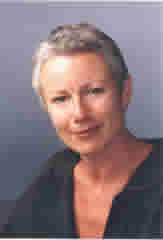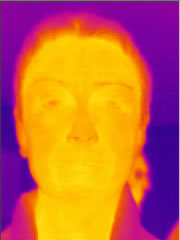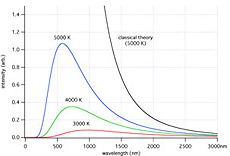Abstract
An infrared camera with thermal imaging capability produces images in the midwave infrared and can be used to measure temperatures.
This is one of three related demonstrations:
1) Near IR on a Camera: IR with wavelength slightly longer than visible light.
2) IR on a Modified Webcam: Extending the rage of the webcam.
3) Thermal Camera: Can see the “glow” of objects around room temperature.
 |
 |
 |
| Radio New Zealand personality Kim Hill as seen in visible light. | Kim Hill in the infrared. A false colour scheme has been applied with yellow indicating the warmest parts of the face. | A house with single glaze windows A false colour scheme has been applied to the image with yellow indicating warmer. |
Additional images from thermal cameras
Portable
Yes
Principles Illustrated
All objects with a temperature above absolute zero glow. Objects near room temperature glow significantly in the middle of the infrared band more or less, and this glow can be seen with a camera that is sensitive to these wavelengths. “Thermal imaging” cameras use additional technology to determine the temperature of the glowing objects from the infrared radiation they produce. The use of these infrared and thermal imaging cameras is rapidly increasing as their prices decrease. Ours is a thermal imaging camera from Wuhan. You can find a lot of neat images on their website. This is very much a portable device and can be included in our human eye and electromagnetism shows.
NCEA & Science Curriculum
PHYS 2.3, PHYS 3.3, Weaker links to PHYS 2.6, PHYS 3.6
Instructions
You will require a thermal camera. They are expensive but a few organisations will loan them to schools.
Notes

All objects above zero kelvin glow. This glow is often called “blackbody radiation” although a true blackbody is a perfect absorber and emitter of radiation at all wavelengths. Many real objects are approximately blackbodies. The sun, for example, is approximately a blackbody with a surface temperature of about 5780 Kelvin.
Objects at room temperature do not glow significantly in the visible. An incandescent light bulb filament is heated to somewhere around 3000 K (varies according to the type of bulb) and glows partly in the visible part of the spectrum. As you can see from the blackbody radiation graph above, even at this temperature most of the radiation produced by the incandescent bulb is in the infrared rather than in the visible.

Objects near room temperature glow in the middle of the infrared band. Ordinary cameras cannot “see” this radiation, but a midwave infrared camera can. Some images we took with our camera are shown above.
Using somewhat sophisticated algorithms and knowing the emissivity (see below) of the object being viewed (the “target”), the temperature of the target can be determined by special infrared cameras called “thermal imaging” cameras. The process of obtaining the temperature from the infrared radiation is non-trivial.
Infrared and thermal imaging cameras that operate over various parts of the infrared spectrum are finding many uses these days. Here are some examples from astronomy (link to NASA for info on infrared images from Hubble), medicine (link to information on medical infrared imaging from American Infrared Corporation), industrial and military applications. But you can find countless other examples if you look around.
Additional images from thermal cameras
Safety
Individual teachers are responsible for safety in their own classes. Even familiar demonstrations should be practised and safety-checked by individual teachers before they are used in a classroom.
Related Resources
See our demonstrations with near infrared light using an ordinary cell phone or other digital camera, and imaging hot objects using a modified webcam.
References
Teaching Resources
Would you like to contribute lesson suggestions? Contact us.
Credits
We thank Kim Hill for allowing us to use her photos in the visible and infrared. The infrared photo was taken at one of the VIP Science Series classes offered by The Royal Society of New Zealand to well-known and influential New Zealanders.
This teaching resource was developed with support from
The MacDiarmid Institute
Faculty of Science, Victoria University of Wellington
School of Chemical and Physical Sciences, Victoria University of Wellington